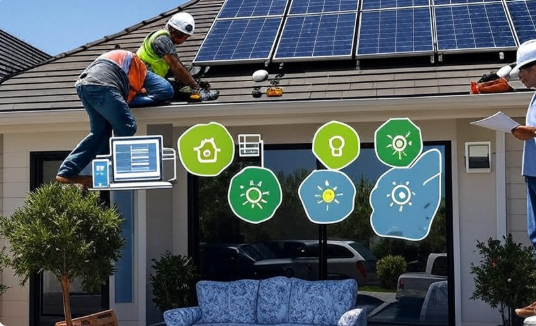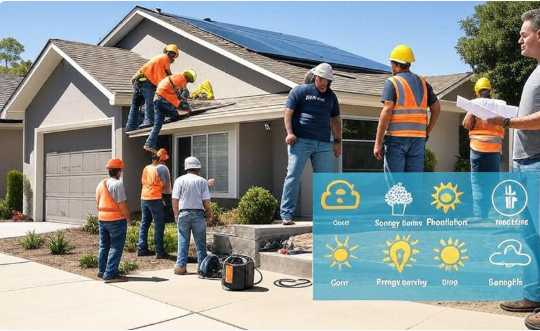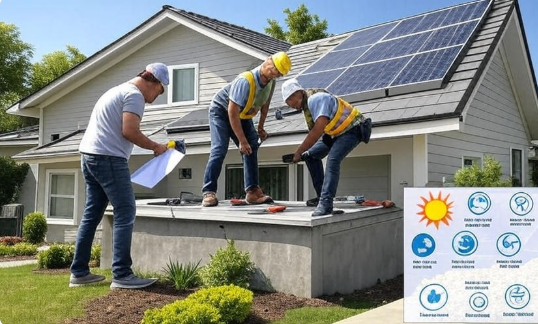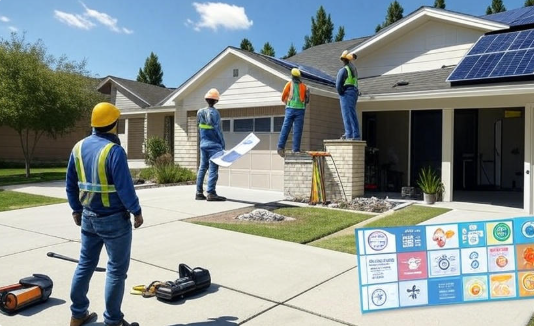As the world transitions to cleaner energy sources, solar power has emerged as a popular choice for homeowners looking to reduce energy costs, increase home value, and contribute to a more sustainable future. If you’re considering making the switch, you’re likely overwhelmed by the technical details, financial considerations, and regulatory requirements. This article aims to serve as a comprehensive, practical guide to solar panel installation, offering homeowners everything they need to know before making a significant investment.
Whether you’re motivated by environmental concerns, rising electricity bills, or energy independence, understanding the process and implications of solar installation is crucial. This guide will walk you through the key elements involved in solar panel installation, covering everything from costs and system sizing to maintenance and long-term returns.
Understanding Solar Energy Systems
What Are Solar Panels and How Do They Work?
Solar panels, also known as photovoltaic (PV) panels, convert sunlight into electricity using semiconductor materials that generate electric current when exposed to light. These panels are typically installed on rooftops but can also be mounted on the ground or other structures.
The basic components of a home solar system include:
- Solar panels
- Inverter (converts DC electricity to usable AC electricity)
- Mounting system
- Battery storage (optional but increasingly popular)
- Monitoring system
Types of Solar Panel Systems
- Grid-Tied Systems: Most common; connected to the utility grid.
- Off-Grid Systems: Ideal for remote locations; rely entirely on battery storage.
- Hybrid Systems: Combine grid connection with battery backup for added reliability.
Assessing Your Home’s Solar Potential
Roof Orientation and Tilt
The orientation and tilt of your roof significantly affect solar efficiency. In the Northern Hemisphere, south-facing roofs typically yield the best results. Roofs with a tilt angle between 30 to 45 degrees are optimal, though flat roofs can still accommodate angled mounting systems.
Roof Condition and Material
Before installation, ensure your roof is structurally sound and not due for replacement within the next 10 years. Common roofing materials like asphalt shingles, metal, and concrete tiles are compatible with solar systems.
Shading and Obstructions
Shading from trees, chimneys, or nearby buildings can reduce solar output. A site assessment or solar mapping tool can help determine shading issues throughout the year.
Costs and Financial Incentives
Upfront Costs
Solar installation costs vary widely based on system size, location, and installer rates. As of 2025, the average cost in the U.S. ranges from $2.50 to $3.50 per watt, resulting in a typical 6kW system costing between $15,000 and $21,000 before incentives.
Incentives and Rebates
Government incentives can significantly reduce installation costs. Key options include:
- Federal Investment Tax Credit (ITC): Currently offers a 30% tax credit on system costs.
- State and Local Rebates: Additional savings depending on your location.
- Net Metering: Receive credit for surplus energy sent back to the grid.
- Solar Renewable Energy Certificates (SRECs): Earn tradable credits for every MWh generated.
Financing Options
Homeowners can choose between:
- Cash Purchase: Highest ROI, full ownership.
- Solar Loans: Spread the cost over time.
- Solar Leases or Power Purchase Agreements (PPAs): Lower upfront cost but reduced savings and no ownership.
System Design and Sizing
How to Determine Your Energy Needs
Start by reviewing your electricity bills to calculate your average monthly usage in kilowatt-hours (kWh). This helps determine the size of the solar system needed to offset your consumption.
Sizing Your Solar System
A simple formula:
System Size (kW) = Annual Energy Usage (kWh) / Annual Sunlight Hours / System Efficiency
For example, if your home uses 9,000 kWh annually and your location receives 1,500 effective sunlight hours per year with 80% system efficiency:
9,000 / (1,500 x 0.8) = 7.5 kW system
Choosing the Right Components
- Monocrystalline Panels: Higher efficiency and sleek appearance.
- Polycrystalline Panels: Lower cost but slightly less efficient.
- Microinverters vs. String Inverters: Microinverters allow panel-level optimization, ideal for shaded roofs.
- Battery Storage: Offers backup during outages and better control over energy use.
Selecting a Reputable Installer
What to Look For
- Experience and Certifications: Look for NABCEP-certified or local equivalents.
- Insurance and Licensing: Ensure proper business and electrical licenses.
- Warranties: Preferably 25-year performance and 10–15-year workmanship warranties.
- References and Reviews: Check third-party sites and ask for local references.
Questions to Ask
- How long have you been installing solar systems?
- Can you provide a detailed quote and energy savings estimate?
- Do you handle permits and interconnection?
- What happens if my system underperforms?
Permits, Regulations, and Paperwork
Building Permits
Most municipalities require permits for solar installations. Your installer typically handles this process, which includes submitting designs, structural reports, and safety plans.
Zoning and Homeowner Associations
Check with your local zoning board or HOA to ensure compliance with appearance standards, setbacks, and height restrictions.
Interconnection Agreements
You’ll need to sign an agreement with your utility company to connect your solar system to the grid, outlining how surplus energy is credited.
Installation Timeline and Process
Pre-Installation
- Site Assessment: Verify roof integrity and shading.
- System Design: Custom plans based on your energy usage and site conditions.
- Permitting: Submit and wait for approvals (can take 2–6 weeks).
Installation Day
- Mounting the System: Brackets and racking attached to the roof.
- Wiring and Inverter Installation: Connect solar panels to inverter and main panel.
- Inspection: Electrical and building inspections.
- Grid Connection: Utility installs a net meter and grants permission to operate.
Total time from contract to activation ranges from 1 to 3 months.
Maintenance and Troubleshooting
Routine Maintenance
- Visual Inspection: Every 6–12 months for cracks or debris.
- Cleaning: Remove dust, leaves, and bird droppings; use soft brushes or water.
- Monitoring System: Check performance through online dashboards or apps.
Common Issues
- Inverter Failure: Typically replaced every 10–15 years.
- Wiring Problems: Can occur due to rodents or weather.
- Shading Changes: Tree growth or new buildings may affect output.
Understanding Net Metering and Battery Storage
Net Metering
Net metering allows homeowners to send excess solar energy back to the grid in exchange for energy credits. During times when the system underproduces (e.g., night), you can draw on these credits.
Battery Storage
Adding a battery like the Tesla Powerwall or LG Chem can enhance your system by:
- Providing backup during power outages.
- Enabling energy use during peak rate periods.
- Increasing self-consumption and savings.
Environmental and Property Value Impact
Reducing Carbon Footprint
Solar energy is renewable, non-polluting, and reduces reliance on fossil fuels. A typical residential system can offset 3–4 tons of carbon emissions per year.
Increasing Home Value
Multiple studies indicate that homes with solar systems sell faster and at higher prices. Buyers are increasingly attracted to properties with lower operating costs.
Frequently Asked Questions (FAQs)
1. How long do solar panels last?
Most solar panels come with a 25-year performance warranty and can last up to 30 years with proper maintenance.
2. Can I install solar panels myself?
DIY solar kits exist, but due to safety, permitting, and warranty considerations, professional installation is strongly recommended.
3. What happens during a power outage?
If you have a grid-tied system without a battery, your system will shut down during outages to protect utility workers. A battery backup allows continued operation.
4. Are solar panels worth it in cloudy or cold climates?
Yes. Solar panels work efficiently even in cooler climates and can still generate power on cloudy days, albeit at reduced capacity.
5. Will my system work during winter?
Yes. While output may decrease due to shorter days and snow cover, panels are still effective year-round.
Conclusion
Making the leap to solar energy is a major decision that involves upfront investment, but the long-term benefits in terms of savings, sustainability, and home value are substantial. This guide to Solar Panel Installation: What Homeowners Need to Know has outlined everything from system design and financial incentives to installation and maintenance, equipping you with the knowledge to make an informed choice.
By understanding your home’s solar potential, selecting a qualified installer, and planning for the long haul, you can confidently take the next steps toward energy independence. Whether you choose a simple grid-tied system or a fully integrated battery-backed solution, going solar is a step toward a smarter, cleaner future.
If you’re ready to explore your solar options, start by getting a professional solar assessment today. It’s the first step toward lower energy bills and a greener home.












